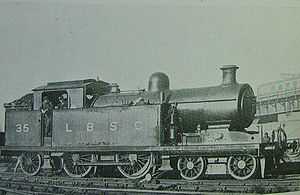LB&SCR I2 class
| LB&SCR I2 & I4 classes | |
|---|---|
|
An I4 incorporating a superheated boiler | |
| Type and origin | |
| Power type | Steam |
| Designer | D.E. Marsh |
| Builder | Brighton Works |
| Build date | 1907-1908 |
| Total produced | I2: 10; I4: 5 |
| Specifications | |
| Configuration | 4-4-2T |
| Gauge | 4 ft 8 1⁄2 in (1,435 mm) |
| Leading wheel diameter | 3 ft 6 in (1.067 m) |
| Driver diameter | 5 ft 6 in (1.676 m) |
| Trailing wheel diameter | 4 ft 0 in (1.219 m) |
| Locomotive weight |
68.5 long tons (69.6 t) I2, 70.25 long tons (71.38 t) I4 |
| Fuel type | Coal |
| Water capacity | 2,238 imp gal (10,170 l; 2,688 US gal) |
| Boiler pressure | 170 psi (1.2 MPa) |
| Cylinders | Two, inside |
| Cylinder size | 17.5 in × 26 in (444 mm × 660 mm) |
| Performance figures | |
| Tractive effort |
I2: 17,425 lbf (77.51 kN), I4: 17,790 lbf (79.13 kN) |
| Career | |
| Retired | 1933-1940 |
The LB&SCR I2 class was a class of 4-4-2 steam tank locomotives designed by D. E. Marsh for suburban passenger service on the London, Brighton and South Coast Railway. The I4 class were of the same design but incorporated a superheated boiler.
History
In 1907, following the failure of his I1 class, Douglas Earle Marsh sought to remedy some of the faults with a new design of 4-4-2T with a longer wheelbase, larger boiler and detailed changes to the front end. In the original order, five of the locomotives would incorporate a superheated boiler, to be supplied by the North British Locomotive Company, and the remainder traditional saturated steam boilers from Brighton Works. In the event, the superheated boilers were delayed in construction and so all ten I2 locomotives had traditional boilers. When the superheated boilers eventually arrived they were used for five further locomotives of the same design, but which were classified I4.
Unfortunately the modifications in these designs did not address the fundamental problems with the I1 class, which was a firebox that was far too small. As a result the two classes had relatively short lives working lightly loaded secondary services, and the Stroudley D1 class, and Billinton D1 class, which they had been designed to replace, continued working.
Numbering
LB&SCR numbers were 11-20 and 31-35. The Southern Railway, which acquired the locomotives in 1923, initially numbered them B11-B20, B31-35 and later 2011-2020, 2031-2035.
Withdrawal
All the I2 were withdrawn between 1933 and 1939 but two locomotives, numbers 2013 and 2019, saw further service on the Longmoor Military Railway where they survived until at least 1947. At Longmoor, they were numbered 2400 and 2401 respectively. These numbers were later changed to 72400 and 72401. None of the class has been preserved. The I4 class were withdrawn between 1936 and 1940. No examples of either class have been preserved.
Locomotive Summary
| LB&SC Number | Built | S.R. Number | Withdrawal | Notes |
|---|---|---|---|---|
| 11 | December 1907 | 2011 | January 1933 | I2 |
| 12 | March 1908 | 2012 | March 1935 | I2 |
| 13 | April 1908 | 2013 | January 1939 | I2, became W.D. 72400 Earl Roberts |
| 14 | April 1908 | 2014 | February 1933 | I2 |
| 15 | May 1908 | 2015 | January 1936 | I2 |
| 16 | June 1908 | 2016 | September 1933 | I2 |
| 17 | July 1908 | 2017 | January 1938 | I2 |
| 18 | July 1908 | 2018 | April 1936 | I2 |
| 19 | July 1908 | 2019 | November 1937 | I2, became W.D. 72401 |
| 20 | August 1908 | 2020 | February 1936 | I2 |
| 31 | September 1908 | 2031 | January 1936 | I4 |
| 32 | November 1908 | 2032 | July 1937 | I4 |
| 33 | November 1908 | 2033 | July 1937 | I4 |
| 34 | December 1908 | 2034 | May 1940 | I4 |
| 35 | January 1909 | 2035 | February 1937 | I4 |
Sources
- Bradley, D.L. (1974). Locomotives of the London Brighton and South Coast Railway: Part 3. Railway Correspondence and Travel Society.
- Dendy Marshall, C. F. (1988). History of the Southern Railway. Ian Allan. ISBN 0-7110-0059-X. page 271,
External links
| ||||||||||||||||||||||||||
